Imperatorin Restores Chemosensitivity of Multidrug-Resistant Cancer Cells by Antagonizing ABCG2-Mediated Drug Transport
Abstract
1. Introduction
2. Results
2.1. Imperatorin Reverses ABCG2-Mediated Multidrug Resistance in Cancer Cells
2.2. Imperatorin Potentiates Topotecan-Induced Apoptosis in ABCG2-Overexpressing Cancer Cells
2.3. Imperatorin Inhibits the Drug Efflux Function of ABCG2
2.4. Imperatorin Does Not Induce Changes in the Protein Expression of ABCG2 in Multidrug-Resistant Cancer Cells
2.5. Imperatorin Stimulates the ATPase Activity of ABCG2
2.6. Docking of Imperatorin in the Drug-Binding Pocket of ABCG2
3. Discussion
4. Materials and Methods
4.1. Materials and Cell Culture
4.2. Cell Viability Assay and Multidrug Resistance Reversal Assay
4.3. Apoptosis Assay
4.4. Fluorescent Drug Accumulation Assay
4.5. Immunoblotting
4.6. ATPase Assay
4.7. Docking Analysis
4.8. Data Analysis
5. Conclusions
Supplementary Materials
Author Contributions
Funding
Data Availability Statement
Conflicts of Interest
References
- Gottesman, M.M. Mechanisms of cancer drug resistance. Annu. Rev. Med. 2002, 53, 615–627. [Google Scholar] [CrossRef] [PubMed]
- Gillet, J.P.; Gottesman, M.M. Mechanisms of multidrug resistance in cancer. Methods Mol. Biol. 2010, 596, 47–76. [Google Scholar] [CrossRef] [PubMed]
- Robey, R.W.; Pluchino, K.M.; Hall, M.D.; Fojo, A.T.; Bates, S.E.; Gottesman, M.M. Revisiting the role of ABC transporters in multidrug-resistant cancer. Nat. Rev. Cancer 2018, 18, 452–464. [Google Scholar] [CrossRef] [PubMed]
- Hegedus, C.; Ozvegy-Laczka, C.; Szakacs, G.; Sarkadi, B. Interaction of ABC multidrug transporters with anticancer protein kinase inhibitors: Substrates and/or inhibitors? Curr. Cancer Drug Targets 2009, 9, 252–272. [Google Scholar] [PubMed]
- Wu, C.-P.; Hsieh, C.-H.; Wu, Y.-S. The Emergence of Drug Transporter-Mediated Multidrug Resistance to Cancer Chemotherapy. Mol. Pharm. 2011, 8, 1996–2011. [Google Scholar] [CrossRef]
- Noguchi, K.; Katayama, K.; Sugimoto, Y. Human ABC transporter ABCG2/BCRP expression in chemoresistance: Basic and clinical perspectives for molecular cancer therapeutics. Pharmacogenom. Pers. Med. 2014, 7, 53–64. [Google Scholar] [CrossRef]
- Pilarski, L.M.; Szczepek, A.J.; Belch, A.R. Deficient drug transporter function of bone marrow-localized and leukemic plasma cells in multiple myeloma. Blood 1997, 90, 3751–3759. [Google Scholar] [CrossRef] [PubMed]
- Schwarzenbach, H. Expression of MDR1/P-glycoprotein, the multidrug resistance protein MRP, and the lung-resistance protein LRP in multiple myeloma. Med. Oncol. 2002, 19, 87–104. [Google Scholar] [CrossRef]
- Turner, J.G.; Gump, J.L.; Zhang, C.; Cook, J.M.; Marchion, D.; Hazlehurst, L.; Munster, P.; Schell, M.J.; Dalton, W.S.; Sullivan, D.M. ABCG2 expression, function, and promoter methylation in human multiple myeloma. Blood 2006, 108, 3881–3889. [Google Scholar] [CrossRef]
- Hofmeister, C.C.; Yang, X.; Pichiorri, F.; Chen, P.; Rozewski, D.M.; Johnson, A.J.; Lee, S.; Liu, Z.; Garr, C.L.; Hade, E.M.; et al. Phase I trial of lenalidomide and CCI-779 in patients with relapsed multiple myeloma: Evidence for lenalidomide-CCI-779 interaction via P-glycoprotein. J. Clin. Oncol. 2011, 29, 3427–3434. [Google Scholar] [CrossRef]
- Ross, D.D.; Karp, J.E.; Chen, T.T.; Doyle, L.A. Expression of breast cancer resistance protein in blast cells from patients with acute leukemia. Blood 2000, 96, 365–368. [Google Scholar] [CrossRef] [PubMed]
- Steinbach, D.; Sell, W.; Voigt, A.; Hermann, J.; Zintl, F.; Sauerbrey, A. BCRP gene expression is associated with a poor response to remission induction therapy in childhood acute myeloid leukemia. Leukemia 2002, 16, 1443–1447. [Google Scholar] [CrossRef] [PubMed]
- Uggla, B.; Stahl, E.; Wagsater, D.; Paul, C.; Karlsson, M.G.; Sirsjo, A.; Tidefelt, U. BCRP mRNA expression v. clinical outcome in 40 adult AML patients. Leuk. Res. 2005, 29, 141–146. [Google Scholar] [CrossRef] [PubMed]
- Matthews, C.; Catherwood, M.A.; Larkin, A.M.; Clynes, M.; Morris, T.C.; Alexander, H.D. MDR-1, but not MDR-3 gene expression, is associated with unmutated IgVH genes and poor prognosis chromosomal aberrations in chronic lymphocytic leukemia. Leuk. Lymphoma 2006, 47, 2308–2313. [Google Scholar] [CrossRef] [PubMed]
- Kovalev, A.A.; Tsvetaeva, D.A.; Grudinskaja, T.V. Role of ABC-cassette transporters (MDR1, MRP1, BCRP) in the development of primary and acquired multiple drug resistance in patients with early and metastatic breast cancer. Exp. Oncol. 2013, 35, 287–290. [Google Scholar]
- Yoh, K.; Ishii, G.; Yokose, T.; Minegishi, Y.; Tsuta, K.; Goto, K.; Nishiwaki, Y.; Kodama, T.; Suga, M.; Ochiai, A. Breast cancer resistance protein impacts clinical outcome in platinum-based chemotherapy for advanced non-small cell lung cancer. Clin. Cancer Res. 2004, 10, 1691–1697. [Google Scholar] [CrossRef]
- Wu, C.P.; Calcagno, A.M.; Ambudkar, S.V. Reversal of ABC drug transporter-mediated multidrug resistance in cancer cells: Evaluation of current strategies. Curr. Mol. Pharmacol. 2008, 1, 93–105. [Google Scholar] [CrossRef]
- Shukla, S.; Wu, C.P.; Ambudkar, S.V. Development of inhibitors of ATP-binding cassette drug transporters: Present status and challenges. Expert. Opin. Drug Metab. Toxicol. 2008, 4, 205–223. [Google Scholar] [CrossRef]
- Wu, C.P.; Ohnuma, S.; Ambudkar, S.V. Discovering natural product modulators to overcome multidrug resistance in cancer chemotherapy. Curr. Pharm. Biotechnol. 2011, 12, 609–620. [Google Scholar] [CrossRef]
- Kumar, A.; Jaitak, V. Natural products as multidrug resistance modulators in cancer. Eur. J. Med. Chem. 2019, 176, 268–291. [Google Scholar] [CrossRef]
- Sanders, K.; Moran, Z.; Shi, Z.; Paul, R.; Greenlee, H. Natural Products for Cancer Prevention: Clinical Update 2016. Semin. Oncol. Nurs. 2016, 32, 215–240. [Google Scholar] [CrossRef]
- Khalifa, S.A.M.; Elias, N.; Farag, M.A.; Chen, L.; Saeed, A.; Hegazy, M.F.; Moustafa, M.S.; Abd El-Wahed, A.; Al-Mousawi, S.M.; Musharraf, S.G.; et al. Marine Natural Products: A Source of Novel Anticancer Drugs. Mar. Drugs 2019, 17, 491. [Google Scholar] [CrossRef] [PubMed]
- Li, T.; Wang, N.; Zhang, T.; Zhang, B.; Sajeevan, T.P.; Joseph, V.; Armstrong, L.; He, S.; Yan, X.; Naman, C.B. A Systematic Review of Recently Reported Marine Derived Natural Product Kinase Inhibitors. Mar. Drugs 2019, 17, 493. [Google Scholar] [CrossRef] [PubMed]
- Koziol, E.; Skalicka-Wozniak, K. Imperatorin-pharmacological meaning and analytical clues: Profound investigation. Phytochem. Rev. 2016, 15, 627–649. [Google Scholar] [CrossRef] [PubMed]
- Teye Azietaku, J.; Yu, X.A.; Li, J.; Hao, J.; Cao, J.; An, M.; Tan, Z.; Chang, Y.X. Simultaneous Determination of Bergapten, Imperatorin, Notopterol, and Isoimperatorin in Rat Plasma by High Performance Liquid Chromatography with Fluorescence Detection and Its Application to Pharmacokinetic and Excretion Study after Oral Administration of Notopterygium incisum Extract. Int. J. Anal. Chem. 2016, 2016, 9507246. [Google Scholar] [CrossRef] [PubMed]
- Kwon, M.H.; Jeong, J.S.; Ryu, J.; Cho, Y.W.; Kang, H.E. Simultaneous determination of saikosaponin a, paeonol, and imperatorin, components of DA-9805, in rat plasma by LC-MS/MS and application to a pharmacokinetic study. J. Chromatogr. B Anal. Technol. Biomed. Life Sci. 2017, 1068–1069, 289–296. [Google Scholar] [CrossRef] [PubMed]
- Kerekes, D.; Csorba, A.; Gosztola, B.; Nemeth-Zambori, E.; Kiss, T.; Csupor, D. Furocoumarin Content of Fennel-Below the Safety Threshold. Molecules 2019, 24, 2844. [Google Scholar] [CrossRef]
- Zhang, Y.B.; Deng, G.G.; Wang, T.X.; Liu, L.; Yang, X.W. Tissue distribution study of Angelica dahurica cv. Yubaizhi in rat by ultra-performance liquid chromatography with tandem mass spectrometry. J. Pharm. Biomed. Anal. 2019, 174, 43–49. [Google Scholar] [CrossRef]
- Deng, M.; Xie, L.; Zhong, L.; Liao, Y.; Liu, L.; Li, X. Imperatorin: A review of its pharmacology, toxicity and pharmacokinetics. Eur. J. Pharmacol. 2020, 879, 173124. [Google Scholar] [CrossRef]
- Walasek, M.; Grzegorczyk, A.; Malm, A.; Skalicka-Wozniak, K. Bioactivity-guided isolation of antimicrobial coumarins from Heracleum mantegazzianum Sommier & Levier (Apiaceae) fruits by high-performance counter-current chromatography. Food Chem. 2015, 186, 133–138. [Google Scholar] [CrossRef]
- Sancho, R.; Marquez, N.; Gomez-Gonzalo, M.; Calzado, M.A.; Bettoni, G.; Coiras, M.T.; Alcami, J.; Lopez-Cabrera, M.; Appendino, G.; Munoz, E. Imperatorin inhibits HIV-1 replication through an Sp1-dependent pathway. J. Biol. Chem. 2004, 279, 37349–37359. [Google Scholar] [CrossRef] [PubMed]
- Liao, X.; Zhang, Z.; Ming, M.; Zhong, S.; Chen, J.; Huang, Y. Imperatorin exerts antioxidant effects in vascular dementia via the Nrf2 signaling pathway. Sci. Rep. 2023, 13, 5595. [Google Scholar] [CrossRef] [PubMed]
- Li, N.; He, J.; Zhan, Y.; Zhou, N.; Zhang, J. Design, synthesis and preliminary evaluation of novel imperatorin derivatives as vasorelaxant agents. Med. Chem. 2011, 7, 18–23. [Google Scholar] [CrossRef] [PubMed][Green Version]
- Bertin, R.; Chen, Z.; Martinez-Vazquez, M.; Garcia-Argaez, A.; Froldi, G. Vasodilation and radical-scavenging activity of imperatorin and selected coumarinic and flavonoid compounds from genus Casimiroa. Phytomed. Int. J. Phytother. Phytopharm. 2014, 21, 586–594. [Google Scholar] [CrossRef] [PubMed]
- Guo, W.; Sun, J.; Jiang, L.; Duan, L.; Huo, M.; Chen, N.; Zhong, W.; Wassy, L.; Yang, Z.; Feng, H. Imperatorin attenuates LPS-induced inflammation by suppressing NF-kappaB and MAPKs activation in RAW 264.7 macrophages. Inflammation 2012, 35, 1764–1772. [Google Scholar] [CrossRef] [PubMed]
- Yang, I.J.; Lee, D.U.; Shin, H.M. Anti-inflammatory and antioxidant effects of coumarins isolated from Foeniculum vulgare in lipopolysaccharide-stimulated macrophages and 12-O-tetradecanoylphorbol-13-acetate-stimulated mice. Immunopharmacol. Immunotoxicol. 2015, 37, 308–317. [Google Scholar] [CrossRef]
- Okamoto, T.; Yoshida, S.; Kobayashi, T.; Okabe, S. Inhibition of concanavalin A-induced mice hepatitis by coumarin derivatives. Jpn. J. Pharmacol. 2001, 85, 95–97. [Google Scholar] [CrossRef][Green Version]
- Wang, N.; Wu, L.; Cao, Y.; Wang, Y.; Zhang, Y. The protective activity of imperatorin in cultured neural cells exposed to hypoxia re-oxygenation injury via anti-apoptosis. Fitoterapia 2013, 90, 38–43. [Google Scholar] [CrossRef]
- Lee, E.; Choi, S.Y.; Yang, J.H.; Lee, Y.J. Preventive effects of imperatorin on perfluorohexanesulfonate-induced neuronal apoptosis via inhibition of intracellular calcium-mediated ERK pathway. Korean J. Physiol. Pharmacol. 2016, 20, 399–406. [Google Scholar] [CrossRef]
- Gao, K.L.; Li, M.; Zhang, K.P. Imperatorin inhibits the invasion and migration of breast cancer cells by regulating HMGB2. J. Biol. Regul. Homeost. Agents 2021, 35, 227–230. [Google Scholar] [CrossRef]
- Amini, P.; Nodooshan, S.J.; Ashrafizadeh, M.; Aliasgharzadeh, A.; Vakili, Z.; Tavakoli, S.; Aryafar, T.; Musa, A.E.; Najafi, M.; Taeb, S.; et al. Imperatorin Attenuates the Proliferation of MCF-7 Cells in Combination with Radiotherapy or Hyperthermia. Curr. Radiopharm. 2022, 15, 236–241. [Google Scholar] [CrossRef] [PubMed]
- Choochuay, K.; Chunhacha, P.; Pongrakhananon, V.; Luechapudiporn, R.; Chanvorachote, P. Imperatorin sensitizes anoikis and inhibits anchorage-independent growth of lung cancer cells. J. Nat. Med. 2013, 67, 599–606. [Google Scholar] [CrossRef] [PubMed]
- Zheng, Y.M.; Lu, A.X.; Shen, J.Z.; Kwok, A.H.; Ho, W.S. Imperatorin exhibits anticancer activities in human colon cancer cells via the caspase cascade. Oncol. Rep. 2016, 35, 1995–2002. [Google Scholar] [CrossRef] [PubMed]
- Mi, C.; Ma, J.; Wang, K.S.; Zuo, H.X.; Wang, Z.; Li, M.Y.; Piao, L.X.; Xu, G.H.; Li, X.; Quan, Z.S.; et al. Imperatorin suppresses proliferation and angiogenesis of human colon cancer cell by targeting HIF-1alpha via the mTOR/p70S6K/4E-BP1 and MAPK pathways. J. Ethnopharmacol. 2017, 203, 27–38. [Google Scholar] [CrossRef]
- Luo, K.W.; Sun, J.G.; Chan, J.Y.; Yang, L.; Wu, S.H.; Fung, K.P.; Liu, F.Y. Anticancer effects of imperatorin isolated from Angelica dahurica: Induction of apoptosis in HepG2 cells through both death-receptor- and mitochondria-mediated pathways. Chemotherapy 2011, 57, 449–459. [Google Scholar] [CrossRef]
- Am, J.U.; Gong, W.J.; Su, Y.; Mou, Z.B. Imperatorin shows selective antitumor effects in SGC-7901 human gastric adenocarcinoma cells by inducing apoptosis, cell cycle arrest and targeting PI3K/Akt/m-TOR signalling pathway. J. BUON 2017, 22, 1471–1476. [Google Scholar] [PubMed]
- Kimura, Y.; Sumiyoshi, M.; Sakanaka, M.; Taniguchi, M.; Baba, K. In vitro and in vivo antiproliferative effect of a combination of ultraviolet-A and alkoxy furocoumarins isolated from Umbelliferae medicinal plants, in melanoma cells. Photochem. Photobiol. 2013, 89, 1216–1225. [Google Scholar] [CrossRef]
- Badziul, D.; Jakubowicz-Gil, J.; Langner, E.; Rzeski, W.; Glowniak, K.; Gawron, A. The effect of quercetin and imperatorin on programmed cell death induction in T98G cells in vitro. Pharmacol. Rep. 2014, 66, 292–300. [Google Scholar] [CrossRef]
- Lv, M.; Xu, Q.; Zhang, B.; Yang, Z.; Xie, J.; Guo, J.; He, F.; Wang, W. Imperatorin induces autophagy and G0/G1 phase arrest via PTEN-PI3K-AKT-mTOR/p21 signaling pathway in human osteosarcoma cells in vitro and in vivo. Cancer Cell Int. 2021, 21, 689. [Google Scholar] [CrossRef]
- Grabarska, A.; Skalicka-Wozniak, K.; Kielbus, M.; Dmoszynska-Graniczka, M.; Miziak, P.; Szumilo, J.; Nowosadzka, E.; Kowalczuk, K.; Khalifa, S.; Smok-Kalwat, J.; et al. Imperatorin as a Promising Chemotherapeutic Agent Against Human Larynx Cancer and Rhabdomyosarcoma Cells. Molecules 2020, 25, 2046. [Google Scholar] [CrossRef]
- Jeong, K.T.; Lee, E.; Park, N.Y.; Kim, S.G.; Park, H.H.; Lee, J.; Lee, Y.J.; Lee, E. Imperatorin Suppresses Degranulation and Eicosanoid Generation in Activated Bone Marrow-Derived Mast Cells. Biomol. Ther. 2015, 23, 421–427. [Google Scholar] [CrossRef] [PubMed]
- Kartner, N.; Riordan, J.R.; Ling, V. Cell surface P-glycoprotein associated with multidrug resistance in mammalian cell lines. Science 1983, 221, 1285–1288. [Google Scholar] [CrossRef] [PubMed]
- Maliepaard, M.; van Gastelen, M.A.; de Jong, L.A.; Pluim, D.; van Waardenburg, R.C.; Ruevekamp-Helmers, M.C.; Floot, B.G.; Schellens, J.H. Overexpression of the BCRP/MXR/ABCP gene in a topotecan-selected ovarian tumor cell line. Cancer Res. 1999, 59, 4559–4563. [Google Scholar]
- Robey, R.W.; Medina-Perez, W.Y.; Nishiyama, K.; Lahusen, T.; Miyake, K.; Litman, T.; Senderowicz, A.M.; Ross, D.D.; Bates, S.E. Overexpression of the ATP-binding Cassette Half-Transporter, ABCG2 (MXR/BCRP/ABCP1), in Flavopiridol-resistant Human Breast Cancer Cells. Clin. Cancer Res. 2001, 7, 145–152. [Google Scholar] [PubMed]
- Bates, S.E.; Medina-Perez, W.Y.; Kohlhagen, G.; Antony, S.; Nadjem, T.; Robey, R.W.; Pommier, Y. ABCG2 mediates differential resistance to SN-38 (7-ethyl-10-hydroxycamptothecin) and homocamptothecins. J. Pharmacol. Exp. Ther. 2004, 310, 836–842. [Google Scholar] [CrossRef]
- Dai, C.L.; Tiwari, A.K.; Wu, C.P.; Su, X.D.; Wang, S.R.; Liu, D.G.; Ashby, C.R., Jr.; Huang, Y.; Robey, R.W.; Liang, Y.J.; et al. Lapatinib (Tykerb, GW572016) reverses multidrug resistance in cancer cells by inhibiting the activity of ATP-binding cassette subfamily B member 1 and G member 2. Cancer Res. 2008, 68, 7905–7914. [Google Scholar] [CrossRef]
- Galetti, M.; Petronini, P.G.; Fumarola, C.; Cretella, D.; La Monica, S.; Bonelli, M.; Cavazzoni, A.; Saccani, F.; Caffarra, C.; Andreoli, R.; et al. Effect of ABCG2/BCRP Expression on Efflux and Uptake of Gefitinib in NSCLC Cell Lines. PLoS ONE 2015, 10, e0141795. [Google Scholar] [CrossRef] [PubMed]
- Cuestas, M.L.; Castillo, A.I.; Sosnik, A.; Mathet, V.L. Downregulation of mdr1 and abcg2 genes is a mechanism of inhibition of efflux pumps mediated by polymeric amphiphiles. Bioorganic Med. Chem. Lett. 2012, 22, 6577–6579. [Google Scholar] [CrossRef]
- Bhullar, J.; Natarajan, K.; Shukla, S.; Mathias, T.J.; Sadowska, M.; Ambudkar, S.V.; Baer, M.R. The FLT3 inhibitor quizartinib inhibits ABCG2 at pharmacologically relevant concentrations, with implications for both chemosensitization and adverse drug interactions. PLoS ONE 2013, 8, e71266. [Google Scholar] [CrossRef]
- Natarajan, K.; Bhullar, J.; Shukla, S.; Burcu, M.; Chen, Z.S.; Ambudkar, S.V.; Baer, M.R. The Pim kinase inhibitor SGI-1776 decreases cell surface expression of P-glycoprotein (ABCB1) and breast cancer resistance protein (ABCG2) and drug transport by Pim-1-dependent and -independent mechanisms. Biochem. Pharmacol. 2013, 85, 514–524. [Google Scholar] [CrossRef]
- Robey, R.W.; Steadman, K.; Polgar, O.; Morisaki, K.; Blayney, M.; Mistry, P.; Bates, S.E. Pheophorbide a is a specific probe for ABCG2 function and inhibition. Cancer Res. 2004, 64, 1242–1246. [Google Scholar] [CrossRef] [PubMed]
- Ozvegy, C.; Litman, T.; Szakacs, G.; Nagy, Z.; Bates, S.; Varadi, A.; Sarkadi, B. Functional characterization of the human multidrug transporter, ABCG2, expressed in insect cells. Biochem. Biophys. Res. Commun. 2001, 285, 111–117. [Google Scholar] [CrossRef]
- Ozvegy-Laczka, C.; Hegedus, T.; Varady, G.; Ujhelly, O.; Schuetz, J.D.; Varadi, A.; Keri, G.; Orfi, L.; Nemet, K.; Sarkadi, B. High-affinity interaction of tyrosine kinase inhibitors with the ABCG2 multidrug transporter. Mol. Pharmacol. 2004, 65, 1485–1495. [Google Scholar] [CrossRef] [PubMed]
- Wu, C.P.; Sim, H.M.; Huang, Y.H.; Liu, Y.C.; Hsiao, S.H.; Cheng, H.W.; Li, Y.Q.; Ambudkar, S.V.; Hsu, S.C. Overexpression of ATP-binding cassette transporter ABCG2 as a potential mechanism of acquired resistance to vemurafenib in BRAF(V600E) mutant cancer cells. Biochem. Pharmacol. 2013, 85, 325–334. [Google Scholar] [CrossRef]
- Wu, C.P.; Lusvarghi, S.; Wang, J.C.; Hsiao, S.H.; Huang, Y.H.; Hung, T.H.; Ambudkar, S.V. The Selective Class IIa Histone Deacetylase Inhibitor TMP195 Resensitizes ABCB1- and ABCG2-Overexpressing Multidrug-Resistant Cancer Cells to Cytotoxic Anticancer Drugs. Int. J. Mol. Sci. 2019, 21, 238. [Google Scholar] [CrossRef]
- Wu, C.P.; Murakami, M.; Hsiao, S.H.; Chou, A.W.; Li, Y.Q.; Huang, Y.H.; Hung, T.H.; Ambudkar, S.V. Overexpression of ATP-Binding Cassette Subfamily G Member 2 Confers Resistance to Phosphatidylinositol 3-Kinase Inhibitor PF-4989216 in Cancer Cells. Mol. Pharm. 2017, 14, 2368–2377. [Google Scholar] [CrossRef]
- Wu, C.P.; Shukla, S.; Calcagno, A.M.; Hall, M.D.; Gottesman, M.M.; Ambudkar, S.V. Evidence for dual mode of action of a thiosemicarbazone, NSC73306: A potent substrate of the multidrug resistance linked ABCG2 transporter. Mol. Cancer Ther. 2007, 6, 3287–3296. [Google Scholar] [CrossRef]
- Wu, C.P.; Lusvarghi, S.; Wang, J.C.; Hsiao, S.H.; Huang, Y.H.; Hung, T.H.; Ambudkar, S.V. Avapritinib: A Selective Inhibitor of KIT and PDGFRalpha that Reverses ABCB1 and ABCG2-Mediated Multidrug Resistance in Cancer Cell Lines. Mol. Pharm. 2019, 16, 3040–3052. [Google Scholar] [CrossRef]
- Orlando, B.J.; Liao, M. ABCG2 transports anticancer drugs via a closed-to-open switch. Nat. Commun. 2020, 11, 2264. [Google Scholar] [CrossRef]
- Kowal, J.; Ni, D.; Jackson, S.M.; Manolaridis, I.; Stahlberg, H.; Locher, K.P. Structural Basis of Drug Recognition by the Multidrug Transporter ABCG2. J. Mol. Biol. 2021, 433, 166980. [Google Scholar] [CrossRef]
- Jackson, S.M.; Manolaridis, I.; Kowal, J.; Zechner, M.; Taylor, N.M.I.; Bause, M.; Bauer, S.; Bartholomaeus, R.; Bernhardt, G.; Koenig, B.; et al. Structural basis of small-molecule inhibition of human multidrug transporter ABCG2. Nat. Struct. Mol. Biol. 2018, 25, 333–340. [Google Scholar] [CrossRef] [PubMed]
- Dennis, T.; Fanous, M.; Mousa, S. Natural products for chemopreventive and adjunctive therapy in oncologic disease. Nutr. Cancer 2009, 61, 587–597. [Google Scholar] [CrossRef] [PubMed]
- De Vera, A.A.; Gupta, P.; Lei, Z.; Liao, D.; Narayanan, S.; Teng, Q.; Reznik, S.E.; Chen, Z.S. Immuno-oncology agent IPI-549 is a modulator of P-glycoprotein (P-gp, MDR1, ABCB1)-mediated multidrug resistance (MDR) in cancer: In vitro and in vivo. Cancer Lett. 2019, 442, 91–103. [Google Scholar] [CrossRef]
- Rabindran, S.K.; Ross, D.D.; Doyle, L.A.; Yang, W.; Greenberger, L.M. Fumitremorgin C reverses multidrug resistance in cells transfected with the breast cancer resistance protein. Cancer Res. 2000, 60, 47–50. [Google Scholar] [PubMed]
- Allen, J.D.; Schinkel, A.H. Multidrug resistance and pharmacological protection mediated by the breast cancer resistance protein (BCRP/ABCG2). Mol. Cancer Ther. 2002, 1, 427–434. [Google Scholar] [PubMed]
- Liao, Z.G.; Tang, T.; Guan, X.J.; Dong, W.; Zhang, J.; Zhao, G.W.; Yang, M.; Liang, X.L. Improvement of Transmembrane Transport Mechanism Study of Imperatorin on P-Glycoprotein-Mediated Drug Transport. Molecules 2016, 21, 1606. [Google Scholar] [CrossRef]
- Wu, C.P.; Hsiao, S.H.; Murakami, M.; Lu, M.J.; Li, Y.Q.; Hsieh, C.H.; Ambudkar, S.V.; Wu, Y.S. Tyrphostin RG14620 selectively reverses ABCG2-mediated multidrug resistance in cancer cell lines. Cancer Lett. 2017, 409, 56–65. [Google Scholar] [CrossRef]
- Robey, R.W.; Honjo, Y.; Morisaki, K.; Nadjem, T.A.; Runge, S.; Risbood, M.; Poruchynsky, M.S.; Bates, S.E. Mutations at amino-acid 482 in the ABCG2 gene affect substrate and antagonist specificity. Br. J. Cancer 2003, 89, 1971–1978. [Google Scholar] [CrossRef]
- Shen, D.W.; Fojo, A.; Chin, J.E.; Roninson, I.B.; Richert, N.; Pastan, I.; Gottesman, M.M. Human multidrug-resistant cell lines: Increased mdr1 expression can precede gene amplification. Science 1986, 232, 643–645. [Google Scholar] [CrossRef]
- Roschke, A.V.; Tonon, G.; Gehlhaus, K.S.; McTyre, N.; Bussey, K.J.; Lababidi, S.; Scudiero, D.A.; Weinstein, J.N.; Kirsch, I.R. Karyotypic complexity of the NCI-60 drug-screening panel. Cancer Res. 2003, 63, 8634–8647. [Google Scholar]
- Miyake, K.; Mickley, L.; Litman, T.; Zhan, Z.; Robey, R.; Cristensen, B.; Brangi, M.; Greenberger, L.; Dean, M.; Fojo, T.; et al. Molecular cloning of cDNAs which are highly overexpressed in mitoxantrone-resistant cells: Demonstration of homology to ABC transport genes. Cancer Res. 1999, 59, 8–13. [Google Scholar] [PubMed]
- Henrich, C.J.; Bokesch, H.R.; Dean, M.; Bates, S.E.; Robey, R.W.; Goncharova, E.I.; Wilson, J.A.; McMahon, J.B. A high-throughput cell-based assay for inhibitors of ABCG2 activity. J. Biomol. Screen. 2006, 11, 176–183. [Google Scholar] [CrossRef] [PubMed]
- Robey, R.W.; Shukla, S.; Finley, E.M.; Oldham, R.K.; Barnett, D.; Ambudkar, S.V.; Fojo, T.; Bates, S.E. Inhibition of P-glycoprotein (ABCB1)- and multidrug resistance-associated protein 1 (ABCC1)-mediated transport by the orally administered inhibitor, CBT-1((R)). Biochem. Pharmacol. 2008, 75, 1302–1312. [Google Scholar] [CrossRef] [PubMed]
- Ishiyama, M.; Tominaga, H.; Shiga, M.; Sasamoto, K.; Ohkura, Y.; Ueno, K. A combined assay of cell viability and in vitro cytotoxicity with a highly water-soluble tetrazolium salt, neutral red and crystal violet. Biol. Pharm. Bull. 1996, 19, 1518–1520. [Google Scholar] [CrossRef]
- Wu, C.P.; Hsiao, S.H.; Luo, S.Y.; Tuo, W.C.; Su, C.Y.; Li, Y.Q.; Huang, Y.H.; Hsieh, C.H. Overexpression of human ABCB1 in cancer cells leads to reduced activity of GSK461364, a specific inhibitor of polo-like kinase 1. Mol. Pharm. 2014, 11, 3727–3736. [Google Scholar] [CrossRef]
- Vermes, I.; Haanen, C.; Steffens-Nakken, H.; Reutelingsperger, C. A novel assay for apoptosis. Flow cytometric detection of phosphatidylserine expression on early apoptotic cells using fluorescein labelled Annexin V. J. Immunol. Methods 1995, 184, 39–51. [Google Scholar] [CrossRef]
- Hsiao, S.H.; Lu, Y.J.; Yang, C.C.; Tuo, W.C.; Li, Y.Q.; Huang, Y.H.; Hsieh, C.H.; Hung, T.H.; Wu, C.P. Hernandezine, a Bisbenzylisoquinoline Alkaloid with Selective Inhibitory Activity against Multidrug-Resistance-Linked ATP-Binding Cassette Drug Transporter ABCB1. J. Nat. Prod. 2016, 79, 2135–2142. [Google Scholar] [CrossRef]
- Anderson, H.A.; Maylock, C.A.; Williams, J.A.; Paweletz, C.P.; Shu, H.; Shacter, E. Serum-derived protein S binds to phosphatidylserine and stimulates the phagocytosis of apoptotic cells. Nat. Immunol. 2003, 4, 87–91. [Google Scholar] [CrossRef]
- Gribar, J.J.; Ramachandra, M.; Hrycyna, C.A.; Dey, S.; Ambudkar, S.V. Functional characterization of glycosylation-deficient human P-glycoprotein using a vaccinia virus expression system. J. Membr. Biol. 2000, 173, 203–214. [Google Scholar] [CrossRef]
- Ambudkar, S.V. Drug-stimulatable ATPase activity in crude membranes of human MDR1-transfected mammalian cells. Methods Enzym. 1998, 292, 504–514. [Google Scholar]
- Wu, C.P.; Hung, C.Y.; Lusvarghi, S.; Huang, Y.H.; Tseng, P.J.; Hung, T.H.; Yu, J.S.; Ambudkar, S.V. Overexpression of ABCB1 and ABCG2 contributes to reduced efficacy of the PI3K/mTOR inhibitor samotolisib (LY3023414) in cancer cell lines. Biochem. Pharmacol. 2020, 180, 114137. [Google Scholar] [CrossRef] [PubMed]

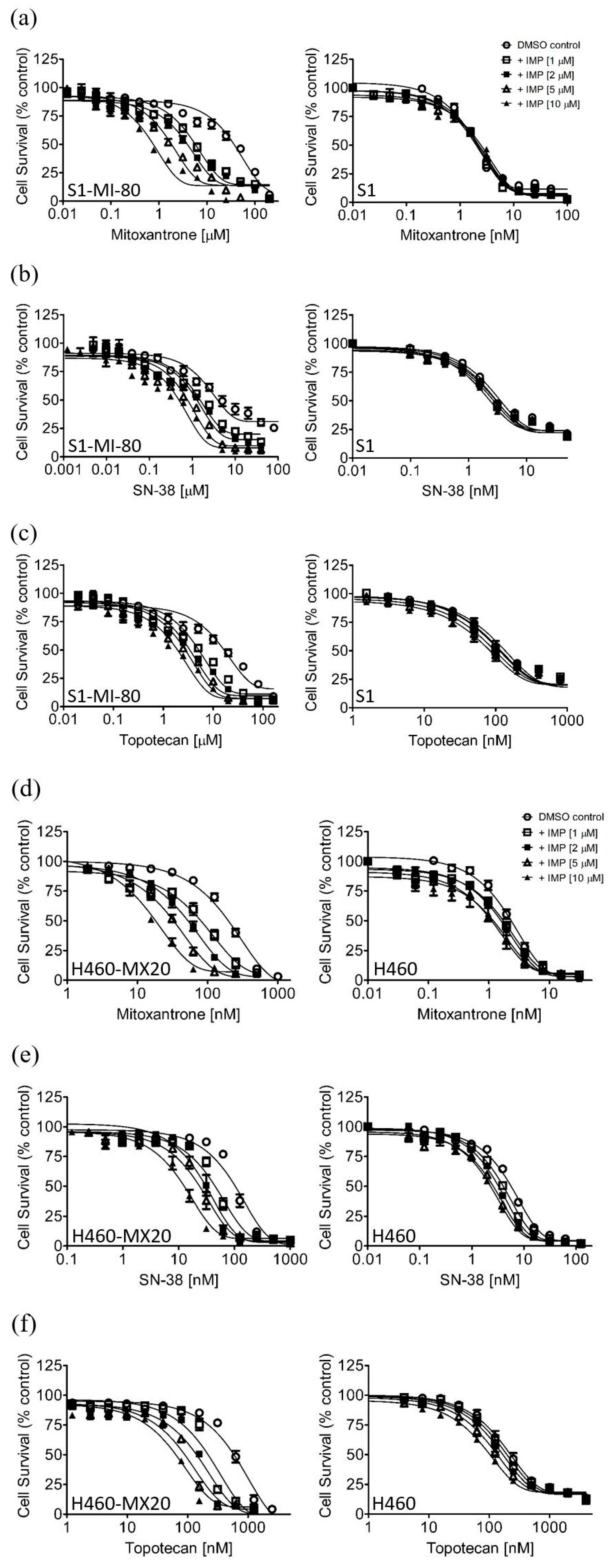
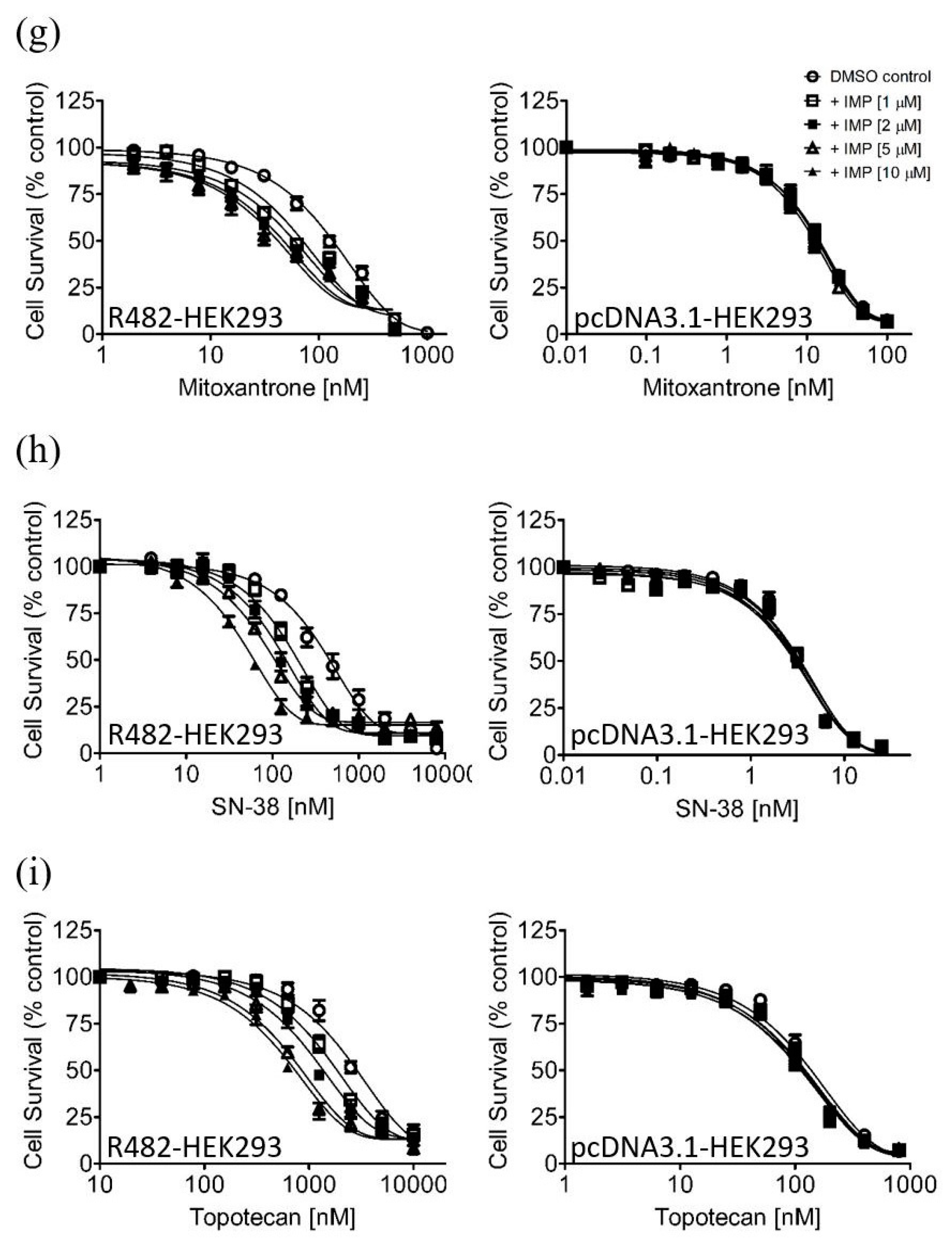

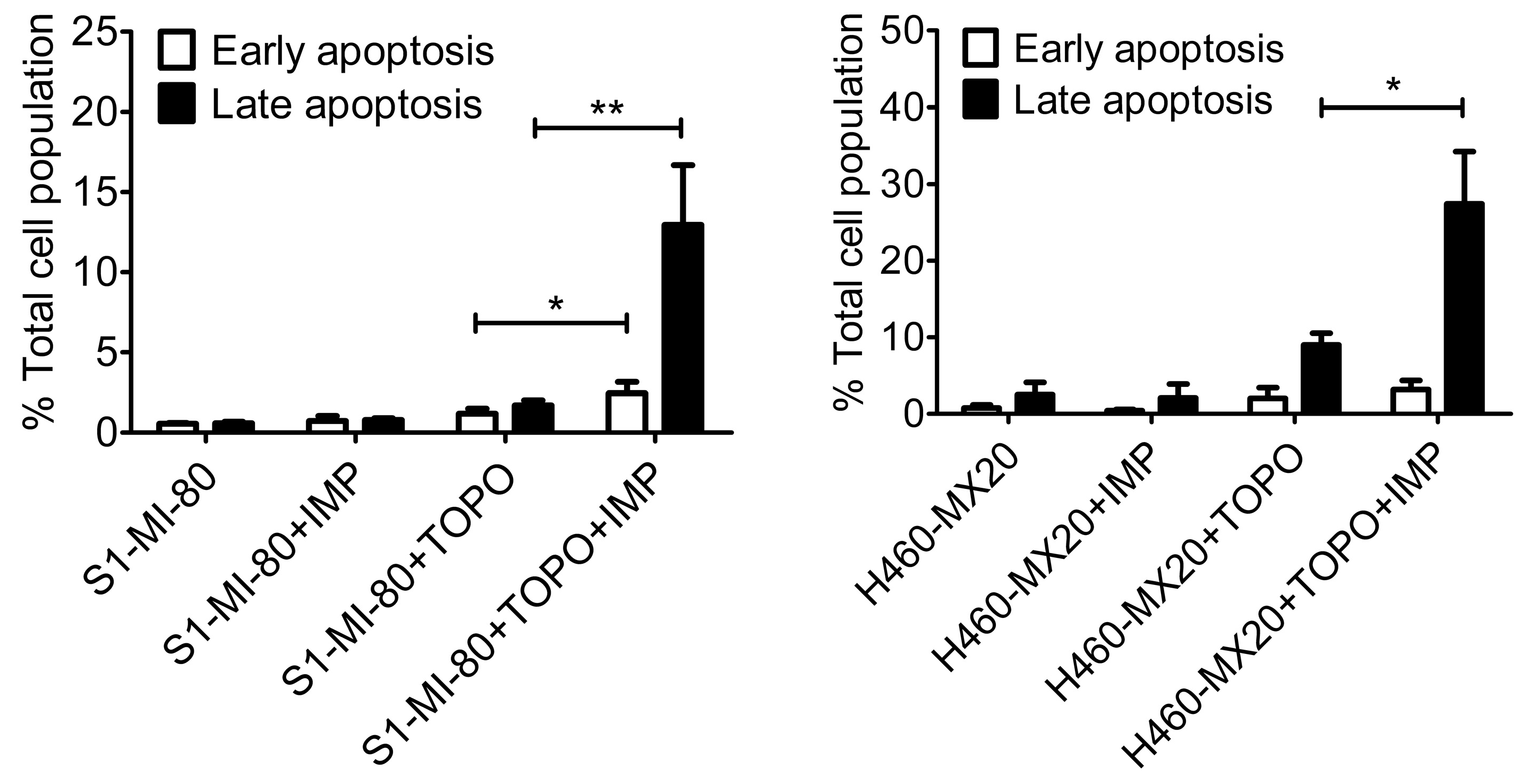
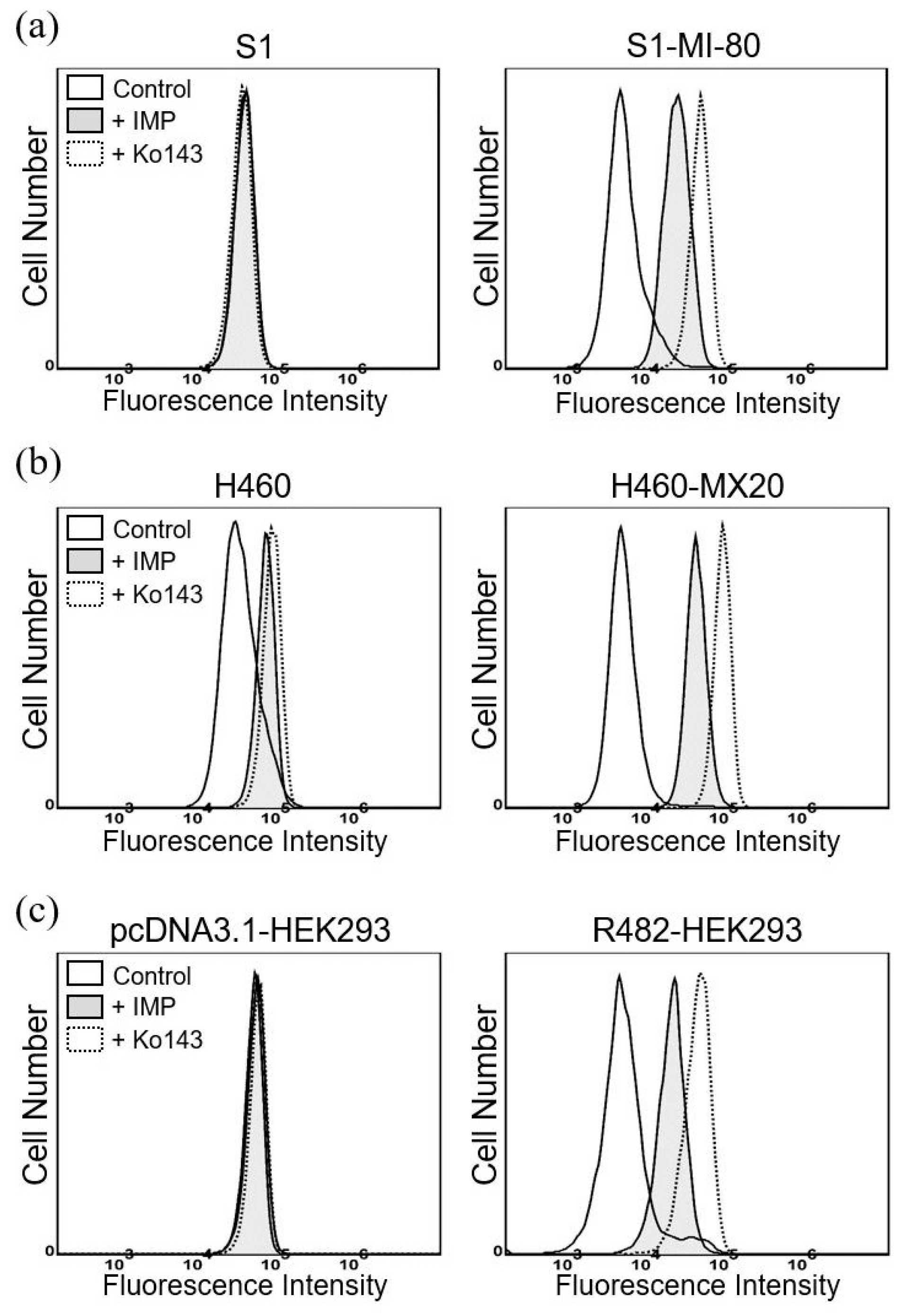
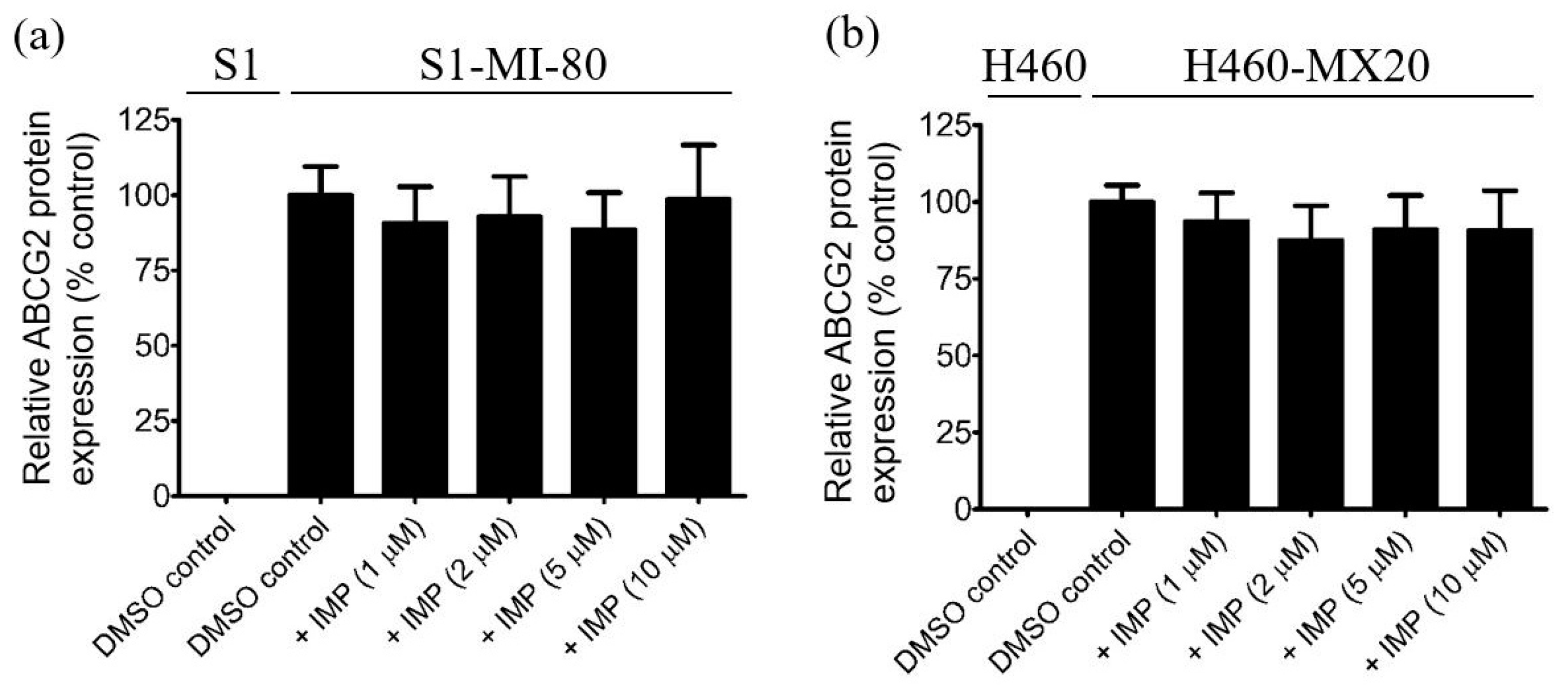
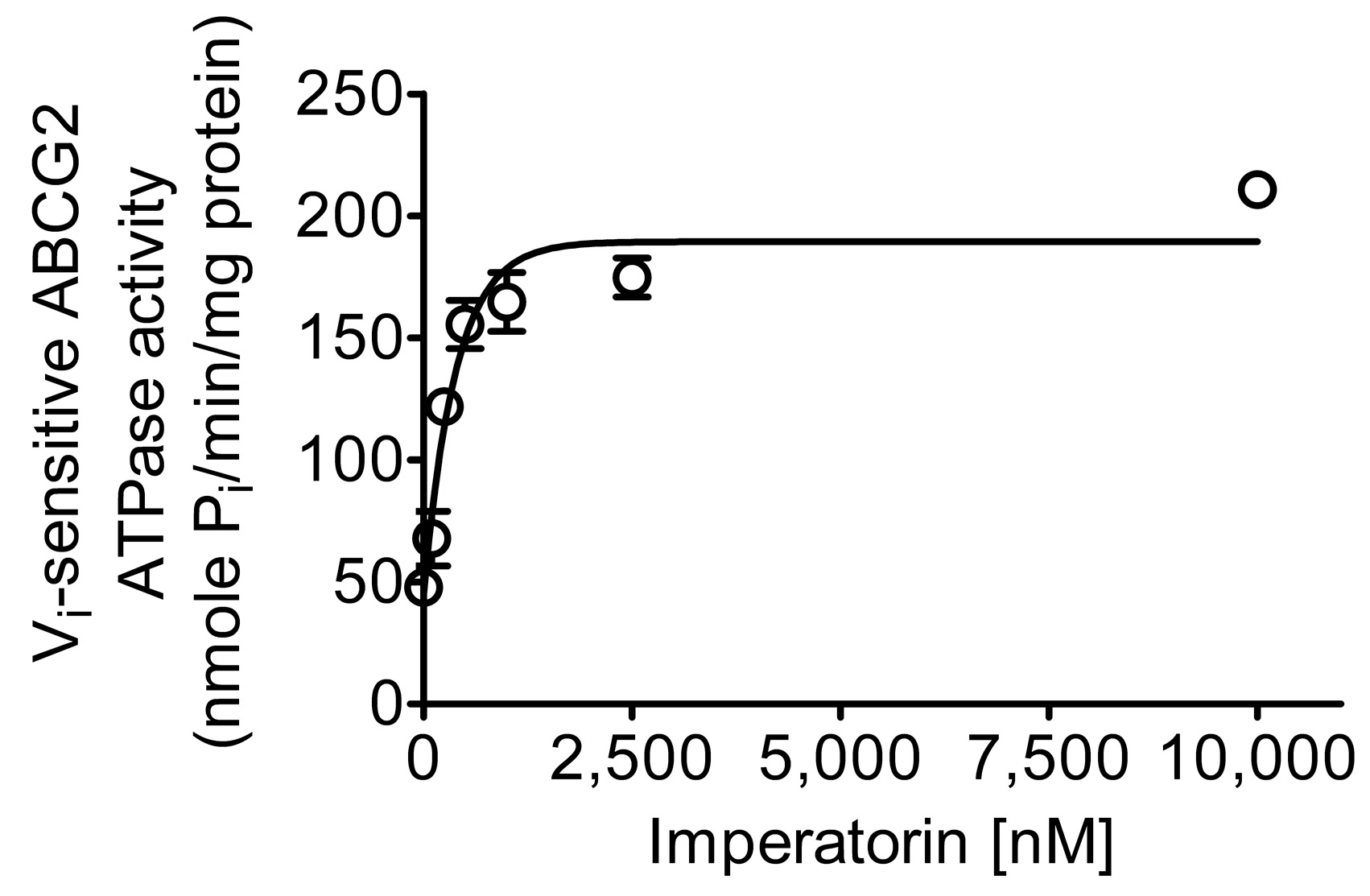
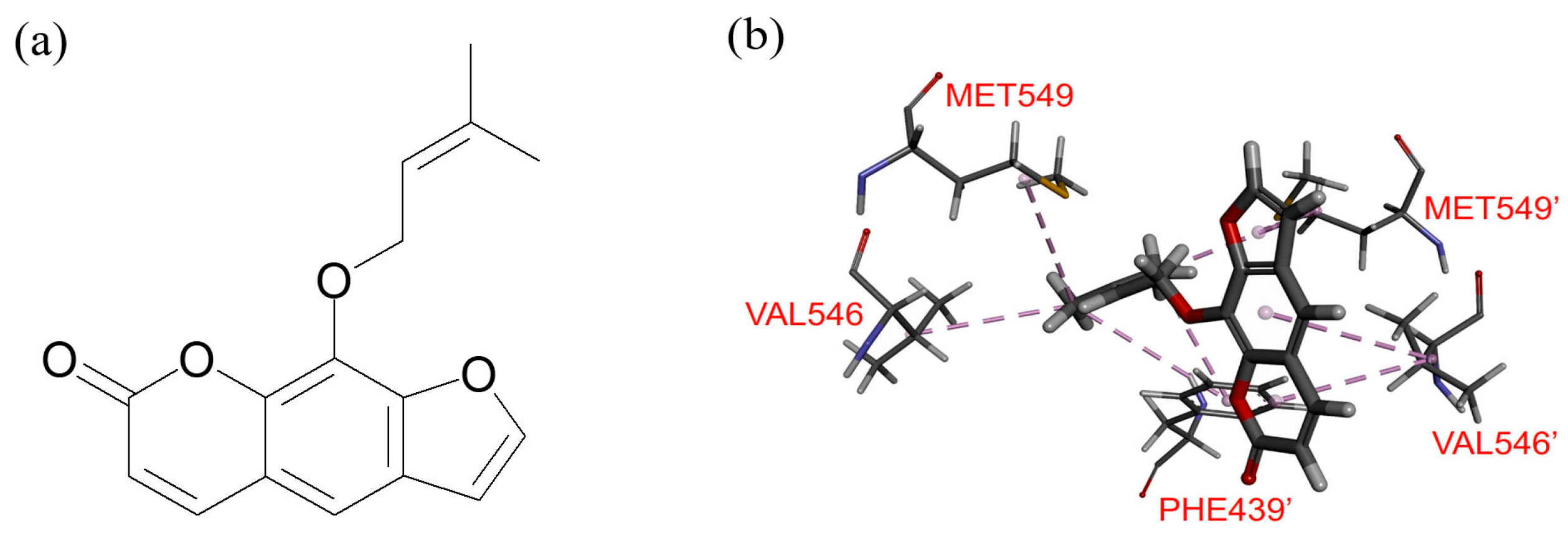
| Mean IC50 1 ± SD and (FR 2) | |||
|---|---|---|---|
| Treatment | Concentration (μM) | OVCAR-8 (Parental) [nM] | NCI-ADR-RES (Resistant) [μM] |
| Colchicine | - | 34.08 ± 9.39 (1.0) | 3.39 ± 0.53 (1.0) |
| +IMP | 1 | 29.11 ± 8.90 (1.2) | 4.23 ± 0.65 (0.8) |
| +IMP | 2 | 40.97 ± 13.15 (0.8) | 4.20 ± 0.67 (0.8) |
| +IMP | 5 | 34.62 ± 9.70 (1.0) | 4.73 ± 0.81 (0.7) |
| +IMP | 10 | 33.81 ± 9.17 (1.0) | 4.51 ± 0.69 (0.8) |
| +Tariquidar | 1 | 28.85 ± 7.53 (1.2) | 37.80 ± 12.70 [nM] *** (90) |
| [nM] | [μM] | ||
| Vincristine | - | 23.65 ± 2.88 (1.0) | 5.77 ± 0.92 (1.0) |
| +IMP | 1 | 26.40 ± 3.04 (0.9) | 8.35 ± 1.72 (0.7) |
| +IMP | 2 | 25.16 ± 2.55 (0.9) | 8.63 ± 1.86 (0.7) |
| +IMP | 5 | 24.11 ± 2.38 (1.0) | 6.95 ± 1.56 (0.8) |
| +IMP | 10 | 20.49 ± 2.75 (1.2) | 5.23 ± 0.97 (1.1) |
| +Tariquidar | 1 | 21.48 ± 2.32 (1.1) | 76.34 ± 15.75 [nM] *** (76) |
| [nM] | [μM] | ||
| Paclitaxel | - | 4.67 ± 0.59 (1.0) | 11.54 ± 2.05 (1.0) |
| +IMP | 1 | 4.44 ± 0.55 (1.1) | 11.10 ± 1.87 (1.0) |
| +IMP | 2 | 4.92 ± 0.76 (0.9) | 11.12 ± 2.12 (1.0) |
| +IMP | 5 | 4.62 ± 0.55 (1.0) | 12.35 ± 2.42 (0.9) |
| +IMP | 10 | 4.23 ± 0.58 (1.1) | 9.33 ± 1.22 (1.2) |
| +Tariquidar | 1 | 4.82 ± 0.72 (1.0) | 7.22 ± 0.73 [nM] *** (1598) |
| Treatment | Concentration (μM) | KB-3-1 (parental) [nM] | KB-V1 (resistant) [μM] |
| Colchicine | - | 10.45 ± 3.44 (1.0) | 1.38 ± 0.27 (1.0) |
| +IMP | 1 | 9.74 ± 2.99 (1.1) | 1.41 ± 0.17 (1.0) |
| +IMP | 2 | 10.26 ± 3.50 (1.0) | 1.53 ± 0.18 (0.9) |
| +IMP | 5 | 11.34 ± 3.96 (0.9) | 1.52 ± 0.17 (0.9) |
| +IMP | 10 | 11.00 ± 3.83 (1.0) | 2.01 ± 0.34 (0.7) |
| +Tariquidar | 1 | 9.40 ± 2.97 (1.1) | 12.52 ± 4.61 [nM] *** (110) |
| [nM] | [μM] | ||
| Vincristine | - | 5.00 ± 1.23 (1.0) | 2.39 ± 0.43 (1.0) |
| +IMP | 1 | 4.57 ± 1.08 (1.1) | 2.36 ± 0.38 (1.0) |
| +IMP | 2 | 4.38 ± 0.96 (1.1) | 2.07 ± 0.36 (1.2) |
| +IMP | 5 | 3.92 ± 0.92 (1.3) | 1.84 ± 0.31 (1.3) |
| +IMP | 10 | 3.64 ± 0.82 (1.4) | 1.64 ± 0.30 (1.5) |
| +Tariquidar | 1 | 3.74 ± 0.91 (1.3) | 5.15 ± 1.06 [nM] (464) |
| [nM] | [μM] | ||
| Paclitaxel | - | 1.93 ± 0.68 (1.0) | 3.54 ± 0.53 (1.0) |
| +IMP | 1 | 1.95 ± 0.73 (1.0) | 3.33 ± 0.50 (1.1) |
| +IMP | 2 | 1.69 ± 0.47 (1.1) | 3.46 ± 0.58 (1.0) |
| +IMP | 5 | 1.81 ± 0.54 (1.1) | 2.94 ± 0.50 (1.2) |
| +IMP | 10 | 1.74 ± 0.50 (1.1) | 2.70 ± 0.44 (1.3) |
| +Tariquidar | 1 | 1.93 ± 0.70 (1.0) | 1.83 ± 0.63 [nM] *** (1934) |
| Treatment | Concentration (μM) | pcDNA3.1-HEK293 (parental) [nM] | MDR19-HEK293 (resistant) [nM] |
| Colchicine | - | 14.65 ± 4.29 (1.0) | 313.26 ± 70.20 (1.0) |
| +IMP | 1 | 13.49 ± 2.96 (1.1) | 341.91 ± 63.09 (0.9) |
| +IMP | 2 | 15.13 ± 3.87 (1.0) | 408.47 ± 55.45 (0.8) |
| +IMP | 5 | 15.01 ± 3.60 (1.0) | 419.27 ± 63.99 (0.7) |
| +IMP | 10 | 12.49 ± 3.58 (1.2) | 427.51 ± 45.23 (0.7) |
| +Tariquidar | 1 | 12.75 ± 3.90 (1.1) | 13.06 ± 3.42 ** (24.0) |
| [nM] | [μM] | ||
| Vincristine | - | 17.14 ± 3.75 (1.0) | 1.75 ± 0.23 (1.0) |
| +IMP | 1 | 16.87 ± 3.24 (1.0) | 1.93 ± 0.19 (0.9) |
| +IMP | 2 | 17.89 ± 3.33 (1.0) | 1.41 ± 0.22 (1.2) |
| +IMP | 5 | 15.66 ± 2.98 (1.1) | 1.54 ± 0.16 (1.1) |
| +IMP | 10 | 14.88 ± 2.69 (1.2) | 1.48 ± 0.16 (1.2) |
| +Tariquidar | 1 | 13.35 ± 2.87 (1.3) | 19.49 ± 2.13 [nM] *** (89.8) |
| [nM] | [μM] | ||
| Paclitaxel | - | 3.80 ± 0.87 (1.0) | 4.76 ± 0.83 (1.0) |
| +IMP | 1 | 3.10 ± 0.53 (1.2) | 4.00 ± 0.62 (1.2) |
| +IMP | 2 | 3.19 ± 0.58 (1.2) | 3.30 ± 0.51 (1.4) |
| +IMP | 5 | 3.47 ± 0.64 (1.1) | 3.47 ± 0.49 (1.4) |
| +IMP | 10 | 2.76 ± 0.48 (1.4) | 3.39 ± 0.58 (1.4) |
| +Tariquidar | 1 | 2.48 ± 0.41 (1.5) | 4.76 ± 0.72 [nM] *** (1000) |
| Mean IC50 1 ± SD and (FR 2) | |||
|---|---|---|---|
| Treatment | Concentration (μM) | S1 (Parental) [nM] | S1-MI-80 (Resistant) [μM] |
| Mitoxantrone | - | 1.97 ± 0.34 (1.0) | 37.48 ± 5.45 (1.0) |
| +IMP | 1 | 1.97 ± 0.26 (1.0) | 7.02 ± 0.87 *** (5.3) |
| +IMP | 2 | 2.07 ± 0.25 (1.0) | 5.19 ± 0.84 *** (7.2) |
| +IMP | 5 | 2.16 ± 0.23 (0.9) | 2.11 ± 0.26 *** (17.8) |
| +IMP | 10 | 2.39 ± 0.24 (0.8) | 0.89 ± 0.10 *** (42.1) |
| +Ko143 | 1 | 1.91 ± 0.31 (1.0) | 0.26 ± 0.04 *** (144.2) |
| [nM] | [μM] | ||
| SN-38 | - | 5.38 ± 1.12 (1.0) | 10.46 ± 2.71 (1.0) |
| +IMP | 1 | 4.43 ± 0.86 (1.2) | 2.21 ± 0.46 ** (4.7) |
| +IMP | 2 | 4.35 ± 0.94 (1.2) | 1.60 ± 0.33 ** (6.5) |
| +IMP | 5 | 5.00 ± 1.17 (1.1) | 797.97 ± 142.95 [nM] ** (13.1) |
| +IMP | 10 | 3.91 ± 1.00 (1.4) | 501.15 ± 91.75 [nM] ** (20.9) |
| +Ko143 | 1 | 4.34 ± 0.91 (1.2) | 164.19 ± 33.28 [nM] ** (65.4) |
| [nM] | [μM] | ||
| Topotecan | - | 163.87 ± 19.28 (1.0) | 19.83 ± 2.43 (1.0) |
| +IMP | 1 | 153.34 ± 23.11 (1.1) | 5.15 ± 0.67 *** (3.9) |
| +IMP | 2 | 144.40 ± 22.21 (1.1) | 3.35 ± 0.48 *** (5.9) |
| +IMP | 5 | 135.88 ± 22.43 (1.2) | 2.65 ± 0.27 *** (7.5) |
| +IMP | 10 | 120.50 ± 21.51 (1.4) | 1.93 ± 0.24 *** (10.3) |
| +Ko143 | 1 | 146.15 ± 18.37 (1.1) | 1.00 ± 0.12 *** (19.8) |
| Treatment | Concentration (μM) | H460 (parental) [nM] | H460-MX20 (resistant) [nM] |
| Mitoxantrone | - | 1.89 ± 0.34 (1.0) | 168.24 ± 38.97 (1.0) |
| +IMP | 1 | 1.68 ± 0.22 (1.1) | 76.44 ± 13.14 * (2.2) |
| +IMP | 2 | 1.46 ± 0.18 (1.3) | 46.79 ± 7.12 ** (3.6) |
| +IMP | 5 | 1.11 ± 0.13 * (1.7) | 29.96 ± 5.22 ** (5.6) |
| +IMP | 10 | 1.23 ± 0.20 * (1.5) | 15.07 ± 2.72 ** (11.2) |
| +Ko143 | 1 | 1.35 ± 0.22 (1.4) | 9.99 ± 1.46 ** (16.8) |
| [nM] | [nM] | ||
| SN-38 | - | 8.36 ± 1.13 (1.0) | 341.27 ± 104.72 (1.0) |
| +IMP | 1 | 5.68 ± 0.65 * (1.5) | 162.63 ± 57.39 (2.1) |
| +IMP | 2 | 4.67 ± 0.67 ** (1.8) | 113.89 ± 42.89 * (3.0) |
| +IMP | 5 | 4.25 ± 0.75 ** (2.0) | 89.98 ± 36.16 * (3.8) |
| +IMP | 10 | 3.58 ± 0.69 ** (2.3) | 75.92 ± 34.46 * (4.5) |
| +Ko143 | 1 | 2.29 ± 0.47 ** (3.7) | 8.54 ± 2.92 ** (40.0) |
| [nM] | [nM] | ||
| Topotecan | - | 244.27 ± 27.29 (1.0) | 1833.76 ± 465.26 (1.0) |
| +IMP | 1 | 215.26 ± 26.33 (1.1) | 700.29 ± 226.08 * (2.6) |
| +IMP | 2 | 186.94 ± 23.76 (1.3) | 618.64 ± 214.38 * (3.0) |
| +IMP | 5 | 160.41 ± 23.62 * (1.5) | 467.41 ± 169.84 ** (3.9) |
| +IMP | 10 | 130.68 ± 25.03 ** (1.9) | 333.46 ± 120.22 ** (5.5) |
| +Ko143 | 1 | 116.24 ± 17.19 ** (2.1) | 88.12 ± 30.74 ** (20.8) |
| Treatment | Concentration (μM) | pcDNA3.1-HEK293 (parental) [nM] | R482-HEK293 (resistant) [nM] |
| Mitoxantrone | - | 13.36 ± 1.17 (1.0) | 111.37 ± 14.83 (1.0) |
| +IMP | 1 | 12.80 ± 1.25 (1.0) | 62.41 ± 7.18 ** (1.8) |
| +IMP | 2 | 13.34 ± 1.40 (1.0) | 58.94 ± 7.72 ** (1.9) |
| +IMP | 5 | 11.57 ± 1.33 (1.2) | 48.56 ± 5.84 ** (2.3) |
| +IMP | 10 | 12.58 ± 1.57 (1.1) | 44.19 ± 5.01 ** (2..5) |
| +Ko143 | 1 | 12.24 ± 1.02 (1.1) | 15.59 ± 1.30 *** (7.1) |
| [nM] | [nM] | ||
| SN-38 | - | 3.02 ± 0.65 (1.0) | 425.18 ± 27.55 (1.0) |
| +IMP | 1 | 3.08 ± 0.67 (1.0) | 180.40 ± 26.30 *** (2.4) |
| +IMP | 2 | 2.77 ± 0.56 (1.1) | 133.51 ± 19.25 *** (3.2) |
| +IMP | 5 | 3.01 ± 0.64 (1.0) | 110.63 ± 21.86 *** (3.8) |
| +IMP | 10 | 2.82 ± 0.57 (1.1) | 61.76 ± 13.87 *** (6.9) |
| +Ko143 | 1 | 2.61 ± 0.56 (1.2) | 10.87 ± 1.62 *** (39.1) |
| [nM] | [nM] | ||
| Topotecan | - | 123.83 ± 25.91 (1.0) | 2655.27 ± 495.12 (1.0) |
| +IMP | 1 | 111.53 ± 20.56 (1.1) | 1687.77 ± 271.40 * (1.6) |
| +IMP | 2 | 105.94 ± 21.17 (1.2) | 1275.03 ± 180.51 * (2.1) |
| +IMP | 5 | 108.24 ± 20.17 (1.1) | 844.84 ± 145.95 ** (3.1) |
| +IMP | 10 | 104.79 ± 18.96 (1.2) | 741.15 ± 103.20 ** (3.6) |
| +Ko143 | 1 | 107.26 ± 20.85 (1.2) | 66.52 ± 17.79 *** (39.9) |
Disclaimer/Publisher’s Note: The statements, opinions and data contained in all publications are solely those of the individual author(s) and contributor(s) and not of MDPI and/or the editor(s). MDPI and/or the editor(s) disclaim responsibility for any injury to people or property resulting from any ideas, methods, instructions or products referred to in the content. |
© 2023 by the authors. Licensee MDPI, Basel, Switzerland. This article is an open access article distributed under the terms and conditions of the Creative Commons Attribution (CC BY) license (https://creativecommons.org/licenses/by/4.0/).
Share and Cite
Wu, C.-P.; Murakami, M.; Li, Y.-C.; Huang, Y.-H.; Chang, Y.-T.; Hung, T.-H.; Wu, Y.-S.; Ambudkar, S.V. Imperatorin Restores Chemosensitivity of Multidrug-Resistant Cancer Cells by Antagonizing ABCG2-Mediated Drug Transport. Pharmaceuticals 2023, 16, 1595. https://doi.org/10.3390/ph16111595
Wu C-P, Murakami M, Li Y-C, Huang Y-H, Chang Y-T, Hung T-H, Wu Y-S, Ambudkar SV. Imperatorin Restores Chemosensitivity of Multidrug-Resistant Cancer Cells by Antagonizing ABCG2-Mediated Drug Transport. Pharmaceuticals. 2023; 16(11):1595. https://doi.org/10.3390/ph16111595
Chicago/Turabian StyleWu, Chung-Pu, Megumi Murakami, Yen-Ching Li, Yang-Hui Huang, Yu-Tzu Chang, Tai-Ho Hung, Yu-Shan Wu, and Suresh V. Ambudkar. 2023. "Imperatorin Restores Chemosensitivity of Multidrug-Resistant Cancer Cells by Antagonizing ABCG2-Mediated Drug Transport" Pharmaceuticals 16, no. 11: 1595. https://doi.org/10.3390/ph16111595
APA StyleWu, C.-P., Murakami, M., Li, Y.-C., Huang, Y.-H., Chang, Y.-T., Hung, T.-H., Wu, Y.-S., & Ambudkar, S. V. (2023). Imperatorin Restores Chemosensitivity of Multidrug-Resistant Cancer Cells by Antagonizing ABCG2-Mediated Drug Transport. Pharmaceuticals, 16(11), 1595. https://doi.org/10.3390/ph16111595







